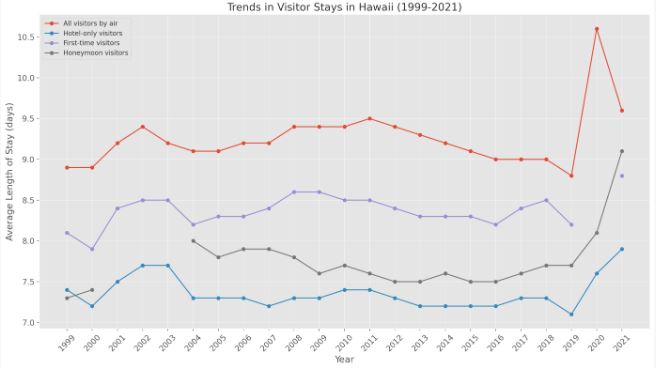Understanding the behavior and preferences of tourists is crucial for any destination aiming to enhance its appeal and service quality. In Hawaii, a prominent travel destination known for its enchanting beauty and cultural heritage, the duration of tourists’ stays can offer invaluable insights. In this article, we’ll explore the trends in the length of stay for different visitor groups from 1999 to 2021.
At a Glance

Detailed Analysis of Visitor Stay Trends
All Visitors by Air:
The length of stay for general visitors traveling by air has seen minor fluctuations over the years, with most changes being within a 2-3% range. However, the data reveals an exceptional spike in 2020, with a 20.45% increase in the average length of stay compared to 2019. This sharp rise can be attributed to the global impact of the COVID-19 pandemic, which led to unprecedented travel restrictions, lockdowns, and a general atmosphere of uncertainty. Many visitors might have found themselves extending their stays either due to imposed restrictions or out of choice, to avoid traveling during peak pandemic times. The subsequent decrease in 2021 hints at a return towards pre-pandemic travel behaviors, though the length of stay still remains above the pre-pandemic average.
Hotel-only Visitors:
“Hotel-only visitors” typically choose to stay exclusively in hotels during their trip, potentially seeking a specific kind of experience. Their length of stay tends to be slightly shorter compared to the general visitor population.
Over the years, their stay duration has seen fluctuations, similar to the general trend observed for all visitors by air. Notable is the increase in 2020, which, while significant, is not as pronounced as the spike for all visitors. This could indicate that while these visitors were impacted by the pandemic’s challenges, they might not have extended their stays as much as other groups. The reasons could range from cost considerations – extended hotel stays can become expensive – to a preference for shorter, more curated experiences even in uncertain times. The subsequent increase in 2021 may suggest that the appeal of hotel-only stays in Hawaii remains strong, with visitors valuing the amenities, convenience, and experiences that hotels offer.

First-time Visitors:
The length of stay for “First-time visitors” to Hawaii offers a glimpse into the island’s appeal to those experiencing its charm for the first time. Over the years, the average duration of stay for this group has remained relatively stable, with only minor fluctuations. This stability is a testament to Hawaii’s enduring allure, consistently attracting new tourists and offering them a memorable experience.
The minor changes observed over the years can be attributed to a variety of factors, from shifts in global travel trends and preferences to external events impacting travel decisions. For instance, the significant increase in 2021 might suggest that after the disruptions of 2020, first-time visitors were more inclined to spend longer durations in Hawaii, possibly making up for postponed trips or savoring their travel experiences more after a challenging year.
While Hawaii’s natural beauty, culture, and activities have consistently drawn first-time visitors, their length of stay also reflects broader trends in the travel industry, economic factors, and global events. The overall trend underscores Hawaii’s success in continuously appealing to new tourists, ensuring they spend a significant amount of time exploring and experiencing the islands.
Honeymooners in Hawaii:
While the data for some years is missing, the available statistics provide insights into the preferences of honeymooners visiting Hawaii. Historically, honeymoon stays have been somewhat shorter than the overall average for all visitors. This could be attributed to honeymooners’ preference for curated, immersive experiences over a shorter duration, or perhaps budget considerations that come with planning a wedding and honeymoon simultaneously.
However, the data also highlights a positive trend in recent years. The gradual increase in the length of stay for honeymoon visitors, especially the 12.35% surge in 2021, suggests that Hawaii is growing in its allure as a premier romantic destination. The islands might be offering more tailored experiences for couples, or perhaps the global travel trends are shifting towards longer, more immersive honeymoons. The pandemic’s influence is also evident, with extended stays in 2020 and 2021 possibly reflecting postponed honeymoon plans or a desire to make the most of the trip after a year of uncertainties.
Overall, Hawaii’s charm, natural beauty, and range of activities make it an ideal destination for couples seeking romance and adventure. The increasing length of stay for honeymooners is a testament to the islands’ continuous efforts to cater to this specific group, ensuring memorable and enchanting experiences.

Final Thoughts:
Exploring the length of stay offers a glimpse into the evolving dynamics of Hawaii’s tourism. The nuanced shifts in stay duration, whether for general visitors, hotel enthusiasts, first-timers, or honeymooners, highlight the islands’ timeless appeal and adaptability to changing global circumstances. It’s evident that Hawaii’s tourism sector is not just about attracting visitors but also about ensuring they have enriching, memorable experiences.
The past years, especially the disruptions brought by the COVID-19 pandemic, have tested the resilience of the travel industry worldwide. Yet, the trends in Hawaii show a destination that has managed not just to weather the storm but to adapt and evolve. The increasing lengths of stay, even in the face of global challenges, underscore Hawaii’s allure and the efforts of its tourism sector to cater to visitors’ changing needs and desires.
As the world of travel continues to change, shaped by technological advancements, environmental concerns, and socio-cultural shifts, it’s intriguing to ponder how these trends might shift in the future. Will we see even longer stays as remote work becomes the norm, allowing travelers to blend vacation and work? Or perhaps, a surge in shorter, eco-conscious trips as sustainable travel gains prominence?
Whatever the future holds, Hawaii, with its rich cultural heritage, natural beauty, and spirit of Aloha, is poised to continue captivating hearts. The islands will undoubtedly keep evolving, reflecting new preferences, overcoming challenges, and seizing fresh opportunities in the ever-changing tapestry of global tourism.
Source of Data: Hawaii Tourism Authority and Hotel performance data prior to March 2017 are from Hospitality Advisors, LLC.

Scott Sweeney is the creator of Virtual Hawaii 360. Scott is a professional marketer and a lifelong Hawaii enthusiast. Scott splits time between Oahu and Dayton, Ohio. In addition to his marketing endevours, he is also a published Ukulele musician.
